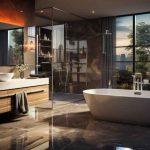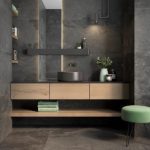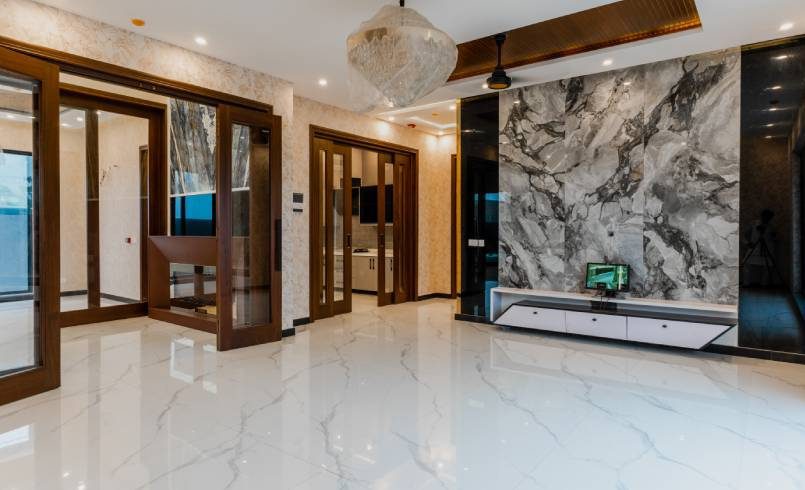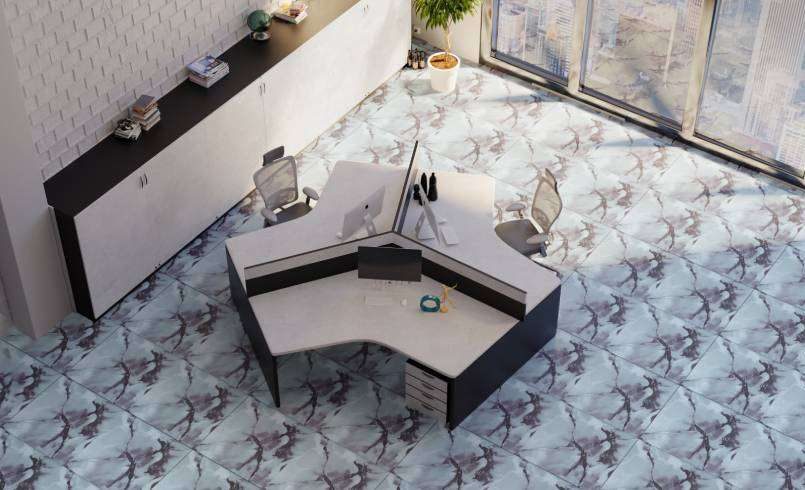When it comes to designing or renovating a space, one of the most crucial decisions is selecting the right flooring. The flooring you choose not only impacts the aesthetic appeal of your home but also its functionality, durability, and overall value. With so many options available, making an informed choice can be challenging. That’s where we come in.As leading vitrified tiles manufacturers, we understand the importance of providing flooring solutions that are not only visually appealing but also durable and cost-effective. Vitrified tiles are rapidly becoming a popular choice for homeowners and businesses alike due to their impressive combination of strength, longevity, and low maintenance.
In this blog, we will delve into a detailed cost comparison between vitrified tiles and other popular flooring options. We’ll explore various factors including initial costs, installation, durability, maintenance, lifespan, and environmental impact. By the end of this comparison, you’ll have a clear understanding of why vitrified tiles are a superior investment for your flooring needs.
Stay with us as we break down these critical aspects and show you how choosing vitrified tiles can enhance the beauty and value of your property while being a wise economic decision.
What is Vitrified Tiles ? Explained!
Vitrified tiles are a type of ceramic tile that are very strong and resistant to stains and water. They are made by mixing clay with other materials and baking them at high temperatures, which makes them denser and less likely to absorb water than regular ceramic tiles. These tiles undergo a specialized manufacturing process called vitrification, which significantly enhances their strength and density compared to traditional ceramic tiles.This process gives vitrified tiles a glass-like finish and makes them durable and easy to clean.
The Vitrification Process
The process of vitrification involves mixing clay with other essential minerals such as silica, quartz, and feldspar. This mixture is then subjected to extremely high temperatures, which causes the materials to melt and fuse together, creating a glass-like, non-porous surface. This fusion process not only makes the tiles denser and more robust but also ensures they are less prone to absorbing water.
Key Advantages of Vitrified Tiles
- Enhanced Durability: Vitrified tiles are incredibly strong and can withstand heavy foot traffic, making them an excellent choice for both residential and commercial spaces.
- Stain Resistance: The non-porous nature of vitrified tiles means they are highly resistant to stains. Spills and dirt can be easily wiped away without leaving any marks, making them ideal for kitchens, bathrooms, and high-traffic areas.
- Water Resistance: Unlike traditional ceramic tiles, vitrified tiles have a very low water absorption rate. This water resistance prevents the growth of mold and mildew, ensuring a healthier environment in moisture-prone areas.
Cost Comparison with Other Materials By Top Vitrified Tiles Manufacturers
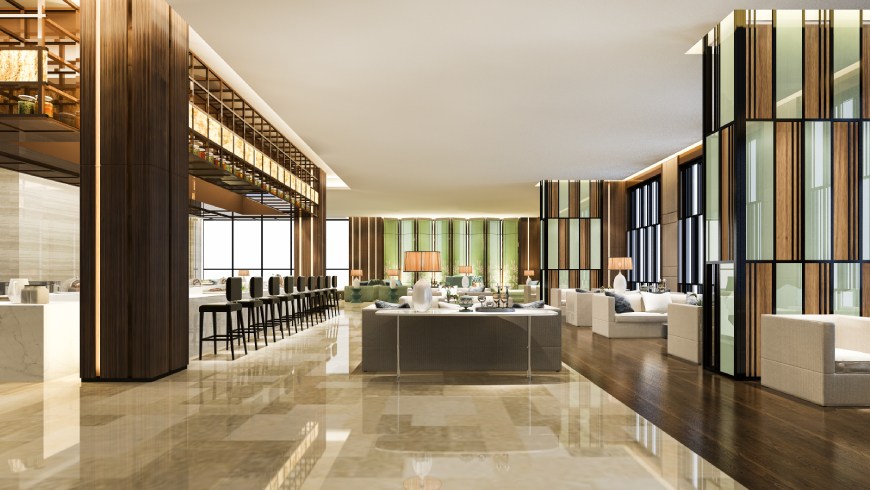
When evaluating flooring options, understanding the cost implications of each material is crucial. Vitrified tiles manufacturers consistently emphasize the long-term value of vitrified tiles compared to other popular flooring materials like marble, wood, and vinyl. Here’s a detailed cost comparison to help you make an informed decision:
|
Flooring Option
|
Cost per sq ft (₹)
|
|---|---|
|
Vitrified Tiles
|
|
|
Tiles up to 32 inches
|
150-250
|
|
Tiles bigger than 32 inches
|
200-300
|
|
Vinyl Flooring
|
|
|
Vinyl sheets
|
65-130
|
|
Vinyl composition tiles (VCT)
|
65-260
|
|
Vinyl planks
|
130-455
|
|
Luxury vinyl tiles (LVT)
|
130-650
|
|
Luxury vinyl planks (LVP)
|
195-650
|
|
Engineered Wood Flooring
|
|
|
Materials
|
260-585
|
|
Installation
|
195-650
|
|
Natural Stone (Marble) Tiles
|
520-2,860
|
Vitrified Tiles vs. Marble
When comparing vitrified tiles and marble, there are significant differences in cost, maintenance, and overall value. Marble, known for its luxurious appeal, comes with a high price tag due to its natural beauty and the labor-intensive processes involved in its extraction and finishing. Additionally, marble installation requires skilled labor, further increasing costs. Maintenance for marble is also demanding; it needs regular sealing and polishing to preserve its appearance, which adds to the long-term expense.
On the other hand, vitrified tiles offer a cost-effective alternative with a similar aesthetic appeal. These tiles are more affordable than marble and are easier and quicker to install, reducing labor costs. Maintenance for vitrified tiles is minimal, requiring only regular cleaning without the need for sealing or polishing. Furthermore, vitrified tiles are highly durable and resistant to stains and moisture, ensuring they retain their look and functionality for many years, making them a superior choice for both residential and commercial spaces.
Vitrified Tiles vs. Wood Flooring
When comparing vitrified tiles to wood flooring, the differences in cost, installation, and maintenance are striking. Wood flooring, especially high-quality hardwood, can be quite expensive and varies significantly in price depending on the type of wood. Installation of wood flooring is labor-intensive and time-consuming, adding to the initial costs. Additionally, wood floors require regular maintenance such as polishing, refinishing, and careful cleaning to prevent damage from scratches and moisture. Over time, these upkeep costs can be substantial.
In contrast, vitrified tiles are more affordable and offer a similar, if not greater, aesthetic variety. Their installation is simpler and quicker, resulting in lower labor costs. Vitrified tiles require minimal maintenance—just regular cleaning to keep them looking new—and are highly resistant to scratches and moisture, making them ideal for areas with heavy traffic or exposure to water. This durability ensures a longer lifespan with fewer replacements, providing significant cost savings in the long run.
Vitrified Tiles vs. Vinyl Flooring
Vinyl flooring is often chosen for its budget-friendly initial cost, but this can be misleading when considering long-term value. Vinyl is relatively easy to install and is less expensive upfront. However, it tends to wear out more quickly, especially in high-traffic areas, and may need replacement every 10-15 years. Additionally, vinyl can suffer from damage and discoloration due to exposure to UV light and heavy use, and it often contains harmful chemicals like phthalates.
Vitrified tiles, although having a higher initial cost, offer superior durability and longevity. They are resistant to scratches, stains, and moisture, making them ideal for a wide range of environments. The maintenance of vitrified tiles is minimal, requiring only routine cleaning without the need for special treatments. Their robust construction ensures they last 15-20+ years, providing excellent long-term value and fewer replacements compared to vinyl flooring. Moreover, the wide range of designs and finishes available with vitrified tiles makes them a versatile and stylish option for any space.
5 Reasons Vitrified Tiles Are a Better Investment Compared to Other Flooring Options
1.Initial Cost and Installation

When considering the initial cost and installation of vitrified tiles, it’s essential to weigh both the upfront expenses and the long-term benefits. Vitrified tiles generally have a higher initial cost compared to other flooring materials like ceramic tiles and laminates. This is due to their advanced manufacturing process, which enhances their durability and aesthetic appeal. However, the installation process of vitrified tiles is quicker and less labor-intensive than some other flooring options. This efficiency can potentially reduce overall labor costs, offsetting the higher initial price. Professional installers can lay vitrified tiles more rapidly, leading to lower labor charges and shorter project timelines.
Wall tile suppliers in India often recommend vitrified tiles not just for their immediate benefits but for their long-term value. Despite the higher upfront cost, vitrified tiles offer superior durability, low maintenance, and extended lifespan, making them a cost-effective investment over time. Their resilience to wear and tear means fewer replacements and repairs, further saving costs in the long run.
2.Maintenance Requirements and Costs
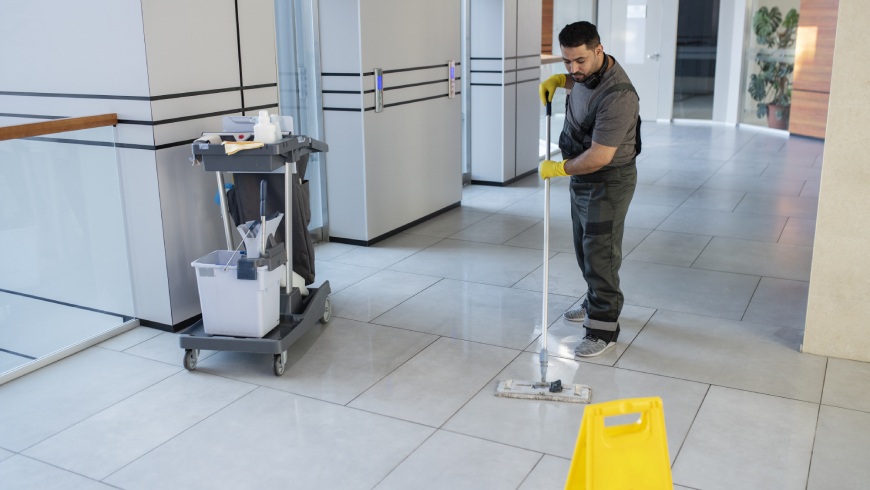
One of the significant advantages of vitrified tiles is their low maintenance requirements. Unlike marble, which needs regular polishing and sealing to maintain its appearance, vitrified tiles require minimal upkeep. A simple routine of sweeping and occasional mopping is sufficient to keep them looking pristine. Wood flooring demands more intensive care, including periodic refinishing and careful cleaning to prevent damage from water and scratches. Vinyl, while easier to maintain than wood, can lose its luster and become less attractive over time.
In terms of costs, the low maintenance needs of vitrified tiles translate into significant savings. With marble, the cost of regular polishing and sealing adds up, making it an expensive option to maintain. Wood flooring also incurs ongoing expenses for refinishing and repairs. Vinyl, although less costly to maintain than marble or wood, still requires attention to avoid wear and tear. Vitrified tiles, with their minimal maintenance needs, save both time and money in the long run.
Strength and Resilience
- Vitrified Tiles: These are extremely strong and resilient due to the vitrification process.
- Marble: Marble is prone to cracking and chipping.
- Wood Flooring: Wood flooring is susceptible to scratches and dents.
- Vinyl Flooring: Vinyl flooring is less durable under heavy use.
Wear and Tear Resistance
- Vitrified Tiles: Highly resistant to scratches and stains, making them ideal for high-traffic areas.
- Marble: Marble can develop scratches and stains over time.
- Wood Flooring: Easily scratched and dented, requiring more care.
- Vinyl Flooring: Wears out quickly in high traffic areas.
Moisture Resistance
- Vitrified Tiles: Non-porous and highly water-resistant, making them perfect for areas exposed to moisture.
- Marble: Marble is porous and absorbs moisture, which can lead to stains.
- Wood Flooring: Sensitive to moisture, it can warp or swell when exposed to water.
- Vinyl Flooring: Water-resistant but can be damaged by standing water.
Impact Resistance
- Vitrified Tiles: Hard and impact-resistant.
- Marble: Less impact-resistant and can chip easily.
- Wood Flooring: Softer and more prone to dents.
- Vinyl Flooring: Prone to dents from heavy objects.
UV and Temperature Resistance
- Vitrified Tiles: Resistant to UV rays and temperature changes.
- Marble: Can discolor under sunlight and is sensitive to temperature changes.
- Wood Flooring: Sensitive to humidity and temperature changes.
- Vinyl Flooring: Can discolor and become damaged by UV rays and extreme temperatures.
Longevity
- Vitrified Tiles: Long lifespan with low maintenance requirements.
- Marble: Requires regular maintenance and has a shorter lifespan compared to vitrified tiles.
- Wood Flooring: Needs refinishing and repairs over time, resulting in a shorter lifespan.
- Vinyl Flooring: Has a shorter lifespan and requires replacement sooner.
Maintenance Needs
- Vitrified Tiles: Low maintenance and easy to clean.
- Marble: Requires regular polishing and sealing.
- Wood Flooring: Needs regular cleaning and refinishing.
- Vinyl Flooring: Requires regular cleaning and can lose its luster over time.
3.Lifespan and Replacement Costs
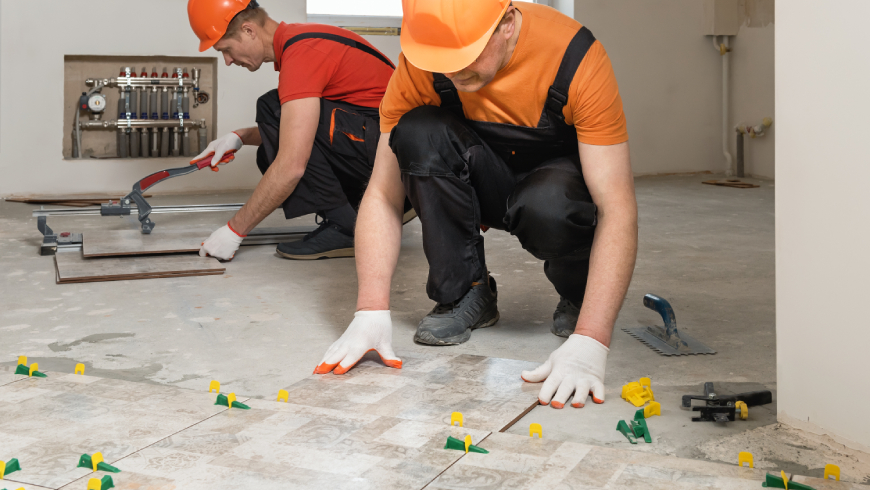
Vitrified tiles are renowned for their impressive lifespan, often lasting 15-20 years or more with minimal maintenance. In contrast, other flooring options such as marble, wood, and vinyl typically require more frequent replacements and upkeep. Marble, though luxurious, can suffer from chips and cracks, necessitating costly repairs or replacement every 10-15 years. Wood flooring, while elegant, is susceptible to scratches, dents, and warping, often requiring refinishing or replacement within 10-20 years. Vinyl flooring, although affordable initially, tends to wear out faster and may need replacement every 10-15 years. The longevity of vitrified tiles translates to lower long-term replacement costs and reduced hassle, making them a more economical and sustainable flooring choice. Vitrified tiles manufacturers ensure their products are built to last, providing excellent value over time.
|
Flooring Type
|
Typical Lifespan
|
Replacement Frequency
|
|---|---|---|
|
Vitrified Tiles
|
15-20+ year
|
Rarely, if ever
|
|
Marble
|
10-15 years
|
Moderate
|
|
Wood Flooring
|
10-20 years
|
Moderate
|
|
Vinyl Flooring
|
10-15 years
|
High
|
4.Environmental Impact
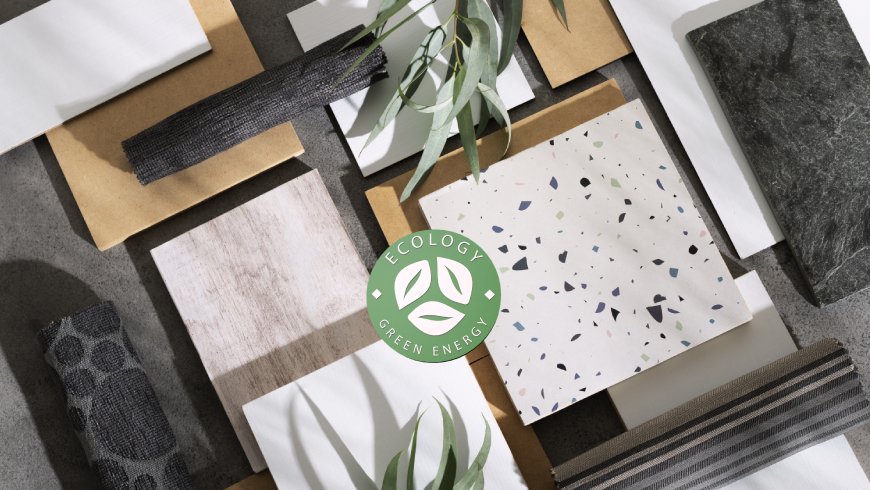
Vitrified tiles are an environmentally friendly flooring option due to their natural composition and eco-conscious manufacturing process. Made from abundant natural materials like clay, silica, and quartz, vitrified tiles do not emit harmful volatile organic compounds (VOCs), contributing to better indoor air quality and a healthier living environment. The production process of vitrified tiles is also more energy-efficient and generates less waste compared to the production of other flooring materials like vinyl, which often contain harmful chemicals and contribute to environmental pollution.
In comparison, marble extraction and processing have a significant environmental impact due to quarrying, which leads to habitat destruction and high energy consumption. Wood flooring, while natural, involves deforestation and can lead to biodiversity loss if not sourced responsibly. Vinyl flooring, although affordable, is made from petroleum-based products and often contains harmful phthalates and plasticizers, which can leach into the environment and are not biodegradable.
Furthermore, the long lifespan and minimal maintenance needs of vitrified tiles reduce their overall environmental footprint, as they require fewer replacements and resources over time. By choosing vitrified tiles from responsible manufacturers, consumers support sustainable building practices and contribute to the conservation of natural resources, making it a conscientious choice for eco-friendly living.
5. Aesthetic Versatility and Designs
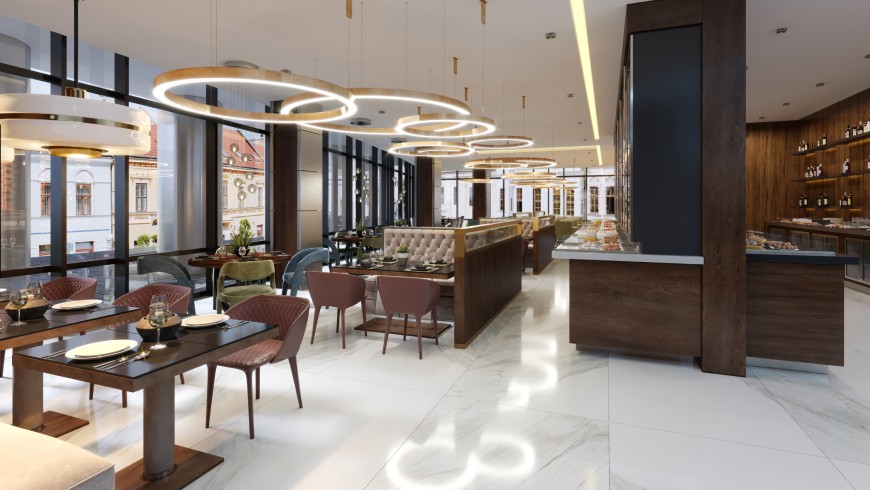
One of the most compelling advantages of vitrified tiles is their exceptional aesthetic versatility. Vitrified tiles manufacturers offer a wide range of designs, colors, and finishes, allowing homeowners and designers to achieve virtually any look they desire. These tiles can mimic the appearance of natural stone, wood, and even intricate patterns, providing a high-end look without the associated costs.
Design Variety: Vitrified tiles come in an extensive palette of colors and styles, from classic whites and neutrals to vibrant hues and contemporary patterns. This vast selection ensures that there is a perfect match for every design theme, whether it be modern, rustic, traditional, or eclectic.
Natural Look: Thanks to advanced manufacturing techniques, vitrified tiles can replicate the look of premium materials like marble, granite, and hardwood. This means you can enjoy the luxurious appearance of these natural materials with the added benefits of durability and ease of maintenance.
Finishes and Textures: Vitrified tiles are available in various finishes, including matte, glossy, textured, and polished. Each finish provides a unique look and feel, allowing you to customize the aesthetic to suit specific areas of your home. For instance, a glossy finish might be ideal for living rooms and hallways, while a matte or textured finish could be perfect for kitchens and bathrooms to provide better slip resistance.
Customization: Many vitrified tiles manufacturers also offer customization options, enabling you to create bespoke designs that perfectly align with your vision. This level of customization is particularly beneficial for commercial projects where branding and unique design elements are essential.
Reach Out to Top Vitrified Tiles Manufacturers in India Today!
In conclusion, while various flooring options each have their own advantages, vitrified tiles stand out for their durability, low maintenance, and long-term cost-effectiveness. Whether compared to marble, wood, or vinyl, vitrified tiles offer a superior blend of aesthetics and functionality, making them an excellent choice for both residential and commercial spaces. Their impressive lifespan and resistance to wear and tear ensure that your investment will look great and perform well for many years to come.
If you’re considering upgrading your flooring, we highly recommend exploring the wide range of options available from reputable vitrified tiles manufacturers. Their expertise and extensive selection can help you find the perfect tiles to match your style and needs. For more information and personalized advice, don’t hesitate to contact us. Transform your space with the best in quality and design—reach out to our experienced team today!



